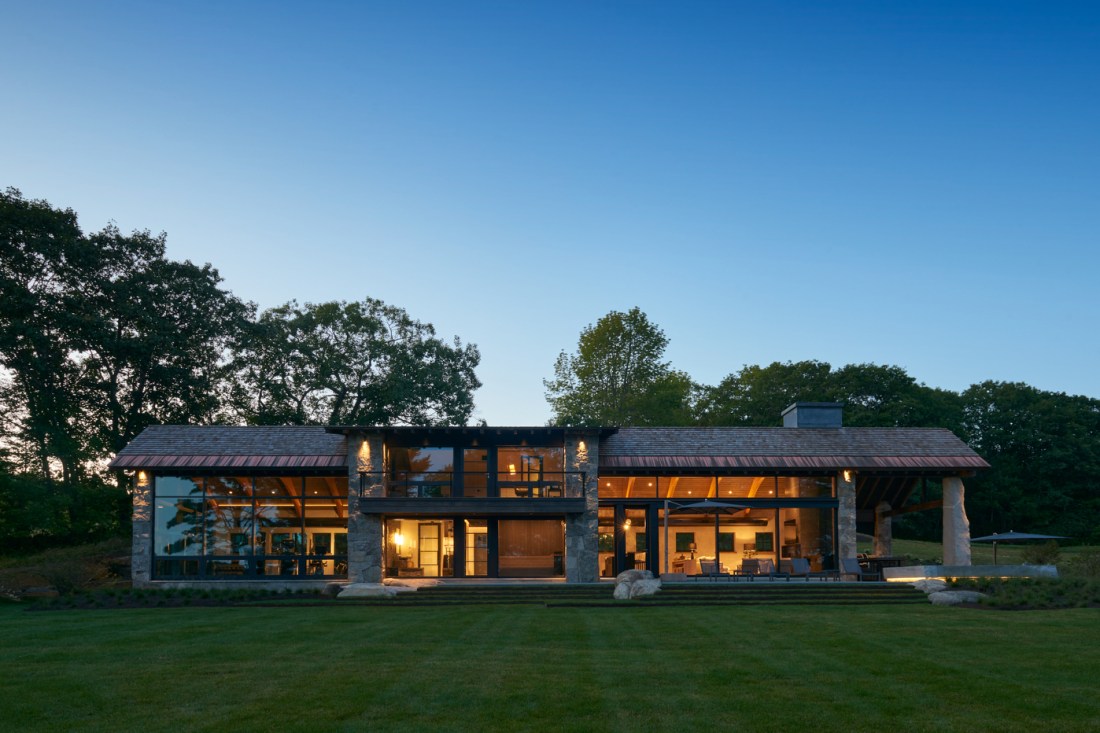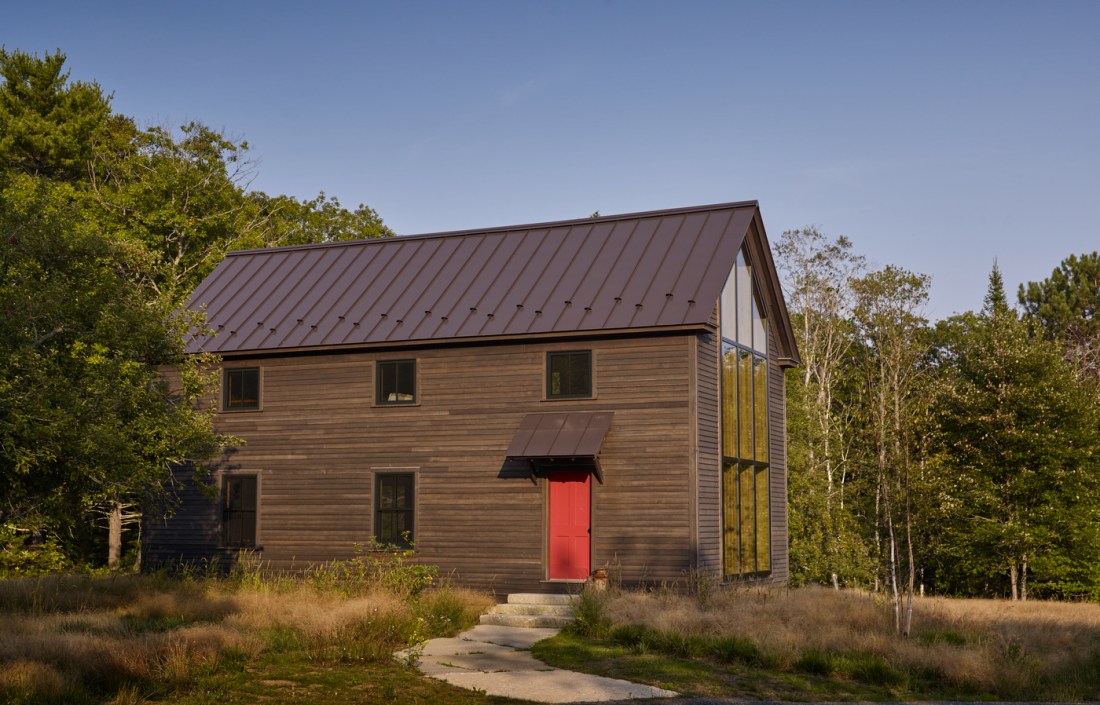Maine architect turns prefab housing into boutique living
Architect and Double Husky Julien Jalbert has crafted an award-winning portfolio of homes and modular “pods” that pushes the boundaries of sustainable modern living.

When Julien Jalbert was 4 years old, he had a vision.
He had just drawn a small house, the kind of thing that for most children would be a fun diversion. For Jalbert, it was a schematic. “I have to build this,” he told his mother.
Decades later, Jalbert’s schematics are a little more detailed. Now an award-winning architect, the Northeastern University graduate has made a name for himself with the Knickerbocker Group, the Maine-based firm where he crafts homes — even prefabricated modular homes or “pods” — that push the boundaries of sustainable design.
“We always as a species have set ourselves apart from other species because we want to have a sense of shelter, a sense of place to keep us safe, a place to enjoy, to call home,” Jalbert says. “Whether it’s at work, at home, industrial buildings, those are spaces that we need to do everything we do day to day.”
Jalbert’s homes jut out over coastal waters and seemingly bring rivers into the home with walls of glass and unobstructed views. He weaves nature into the very structure of his homes, with granite, red cedar and wool sheared from local sheep.
His work has been widely celebrated within the architecture world. He was most recently named in New England Home’s Five Under 40 Class of 2025 and has received countless accolades from the American Institute of Architects.
Despite his childhood dreams, so much of Jalbert’s work, particularly his innovations in modular housing, traces back to his time at Northeastern University where Jalbert received both his bachelor’s and master’s degrees.

Jalbert’s first exposure to modular housing, prefabricated units that are designed to be built fast, sustainably and affordably, came while studying under Ivan Rupnick, an associate professor of architecture and modular housing guru. As a student, Jalbert envisioned a factory where homes could be completely designed and constructed to later be shipped out.
“It was this kind of dream which I ultimately ended up bringing to Maine as a reality,” Jalbert says.
After starting at the Knickerbocker Group in 2017, Jalbert co-founded the firm’s prefab pod division, one of only four modular housing providers in Maine.
“Modular housing and prefabrication in general is the wave of the future in that it minimizes waste, cuts down on schedule timeframes,” Jalbert says. “You build in an environment where your project barely sees any rain or sleet or snow, which can be detrimental to the skeleton of the house.”
Where many prefab homes are built piecemeal and then constructed onsite, Knickerbocker’s homes are built entirely in-factory as “one box that ships down the road,” Jalbert says. Usually, the only thing that needs to be done is to hook up the main electrical and water connections, “almost like a plug-and-play scenario.”
His modular homes are also built for maximum sustainability. They are entirely electric and are built out of biobased and renewable materials like locally sourced wood fiber and sheep’s wool insulation.



“Julien was by far the most motivated student,” Rupnik says. “We developed a series of studies together of modular construction that have since been included in several publications, including the American Institute of Architects. This work is still being used by me to teach other students at Northeastern.”
Raised in rural New Hampshire, Jalbert grew up with a self-taught “jack of all trades” architect for a father. He ran his own millwork business, made custom moldings and even designed, built and sold homes.
“I grew up around my dad having one of those drafting tables in our house where I’d always see him sketching and drawing things,” Jalbert says.
After a brief detour into studying computer science at Northeastern, Jalbert eventually found his own calling in architecture and never turned back. After receiving his bachelor’s degree in 2011, Jalbert worked for Northeastern’s campus planning and design team, where he had previously co-oped. His team focused on renovations for various university offices, labs and classrooms.


It was there that he started to focus on sustainable design, a passion he took into his master’s program and later his work with Boston-based Sousa Design Architects.
Moving to Maine in 2017 to join the Knickerbocker Group, Jalbert found a state tailormade for the creative, innovative and sustainable design work he had been thinking about for years. During a ride-along on his first day, Jalbert was astonished by not only the homes in coastal Maine but the natural landscape that surrounded them.
Editor’s Picks
The “rocks diving into the coast” and “bluffs and trees and crashing waves” that make up Maine’s coastline are a gift for an architect, Jalbert says. It means he can lean into the state’s natural beauty, even if it presents serious challenges.
“We basically built this house off of the ledge, off of the rock,” Jalbert recalls of one recent project. “We scraped off the rock, we poured the foundation right onto the rock and had these trunks grow out of the rock and then had the house cantilever off of those.”
Another of Jalbert’s designs brought the Sheepscot River into the living room with a wall of glass looking out on the water. For that home, Jalbert spent around 40 hours designing one room, getting into the weeds to make sure every piece was properly aligned.
There’s a reason Jalbert peppers his clients with questions before putting pen to paper. He needs to know how people live. While he designs the structure, it’s ultimately his clients who will fill that home with memories built from daily, intimate interactions with his design, he says.
“Quite frankly, I’ve seen plenty of homes that have been built but not thoroughly designed. You can tell,” Jalbert says. “You can drive by a home where you know someone really thought hard about every little thing. … That’s what I think a good architect does. They think about all the fine, fine details to make everything come together as a cohesive whole.”











